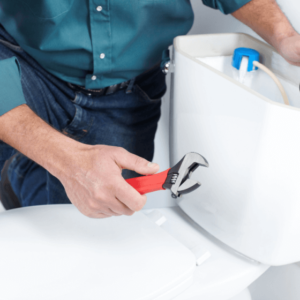A fresh coat of paint is an easy way to spruce up your home’s exterior or your favorite room in the house. But when painting indoors, you should follow certain measures and painting safety precautions to protect yourself and your family.
Step 1: Prepare for Safe Painting
Many interior paint, stain and stripper fumes aren’t just harmful to inhale, they can also be extremely flammable. You should always keep the area well ventilated by opening doors and windows. Use an exhaust fan to remove fumes from your workspace. Never paint or use solvents, strippers, stain, caulking or clean-up supplies near an open flame like the pilot light of a furnace or water heater. And never smoke while painting!
Safety Alerts!
When working with solvent-based materials, it’s best to wear a respirator to prevent inhaling harmful fumes. When sanding, you should wear a dust mask to prevent particles from entering the lungs. If possible, use a power sander with a sawdust collection bag.
If you can avoid it, don’t sleep in a freshly painted room for at least two days.
Use canvas drop cloths instead of plastic on the floor. Cloth stays in place better and is less slippery than the alternative.
Step 2: Be Safe Around Electrical Outlets
Be sure to practice painting safety when painting or working near electrical outlets, cover all exposed outlets with painter’s tape. If you need to remove outlet or switch covers to paint, turn off the power to the room before you start.
Step 3: Use Safe Paint Products
Prime and paint with True Value EasyCare “low-VOC” formulas, such as EasyCare Ultra Premium Interior Paint. These high-quality paint products have reduced amounts of volatile organic compounds (VOCs). Compared to traditional latex paints, these products release fewer fumes. Low-VOC primers and paints are applied the same way as conventional paints and primers and cost about the same as most manufacturers’ top-of-the-line paints. They can be cleaned and disposed of easily without the use of strong solvents.
Safety Alert!
Wear protective gloves and clothing when priming or painting.
Step 4: Test for Lead
Lead-based paint is a major cause of lead poisoning in children and can also be harmful to adults. If your home was built before 1978, you should test painted surfaces like window frames or doorjambs with a lead-testing kit.
Dealing with lead paint has its own set of safety precautions. If a surface tests positive for lead, avoid scraping or using heat to strip. The only way to safely strip lead-based paint is to spray the surface with water and gently scrape off the loose paint. Discard the paint chips immediately and clean the area using a special vacuum cleaner with a HEPA filter attached. It is recommended you hire a professional to complete these tasks.
Step 5: Clean Up and Dispose of Paint Properly
Many people don’t know that leftover latex paint has to dry completely before you can dispose of it. Even if you have used all the paint from a can, allow the empty container to dry with the lid off before discarding. If there is less than a quarter of the can left, you can let the paint dry by leaving it in a well-ventilated area until it hardens, stirring it once every few days. When leaving paint out to dry, be sure to keep it in an area that’s away from children, pets and open flames.
Clean brushes and rollers with non-toxic, citrus-based cleaners or turpentine — an environmentally friendly solvent made from the resin of coniferous trees. For additional tips, see Proper Paint Prep and Cleanup Tips.
Helpful Tips
When purchasing low-VOC paints, only buy what you need for the job at hand. Before you begin, measure the area carefully (height x width = total sq. ft.). One gallon of paint will cover approximately 350 to 400 sq. ft.
Don’t waste paint! Save any leftover paint for touch-up jobs or use it to paint a small area of your home. Think about donating extra paint to someone who can use it, like an artistic friend or a theater group trying to stretch its financial resources.
Step 6: Properly Store Excess Paint
Always store paint in a dry location where the temperature stays above freezing. Replace the lid firmly and store the can upside down to prevent air from entering the container.
If you have young children, it’s a good idea to purchase a lockable storage cabinet for all paints, chemicals and solvents.
Good work. By following these simple tips for safe painting, you can complete any paint project safely.
Project Shopping List
Here’s what you’ll need to complete this project successfully.
- Fan
- Respirator
- Dust mask
- Power sander
- Sawdust collection bag
- Painter’s tape
- Low-VOC paint products
- Protective gloves
- Protective clothing
- Lead testing kit (for homes built before 1978)
- High-powered vacuum cleaner with a HEPA filter
- Paint scraper
- Citrus-based cleaners
- Turpentine
- Lockable storage/utility cabinet (optional)
- EasyCare Ultra Premium Interior Paint












